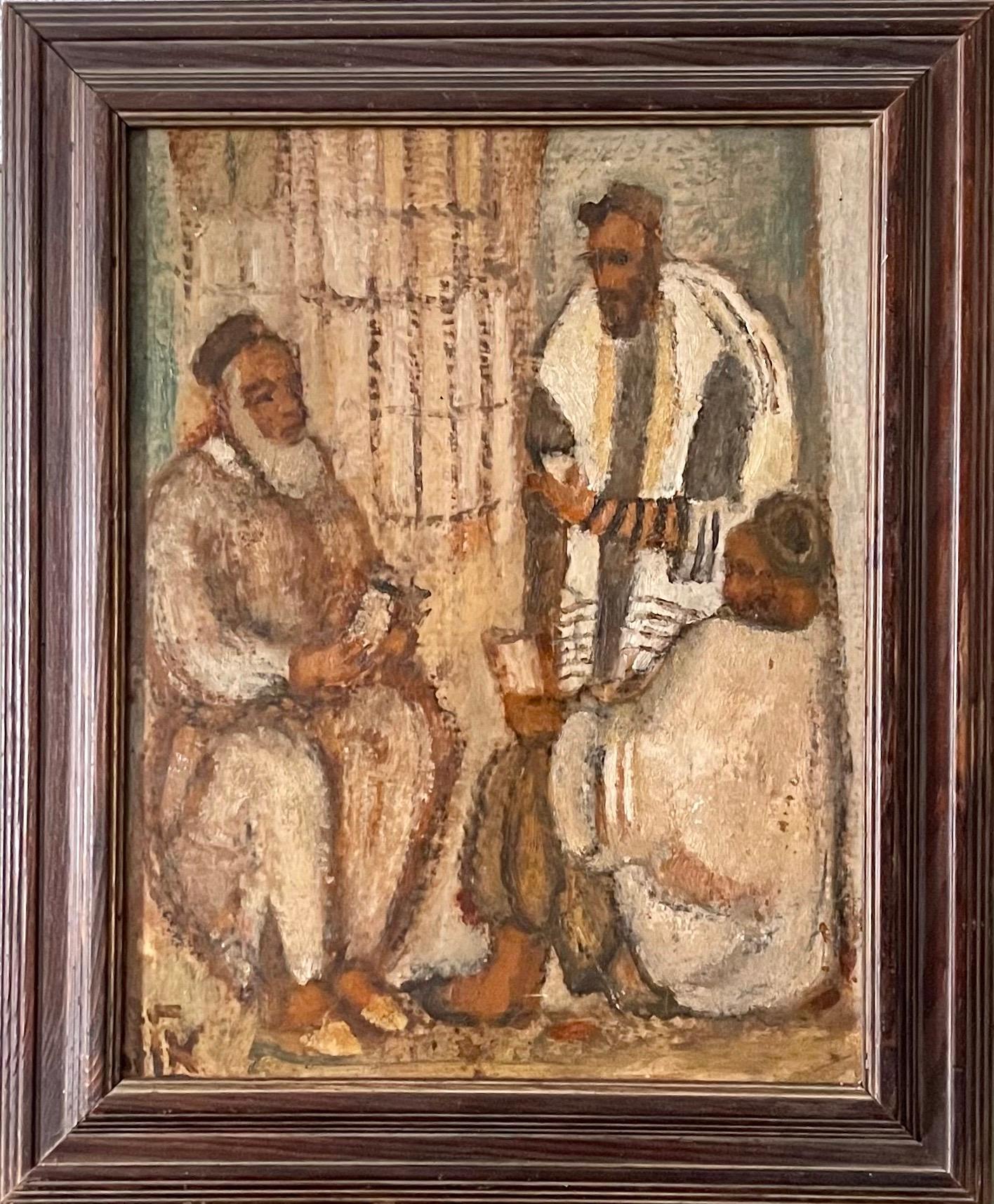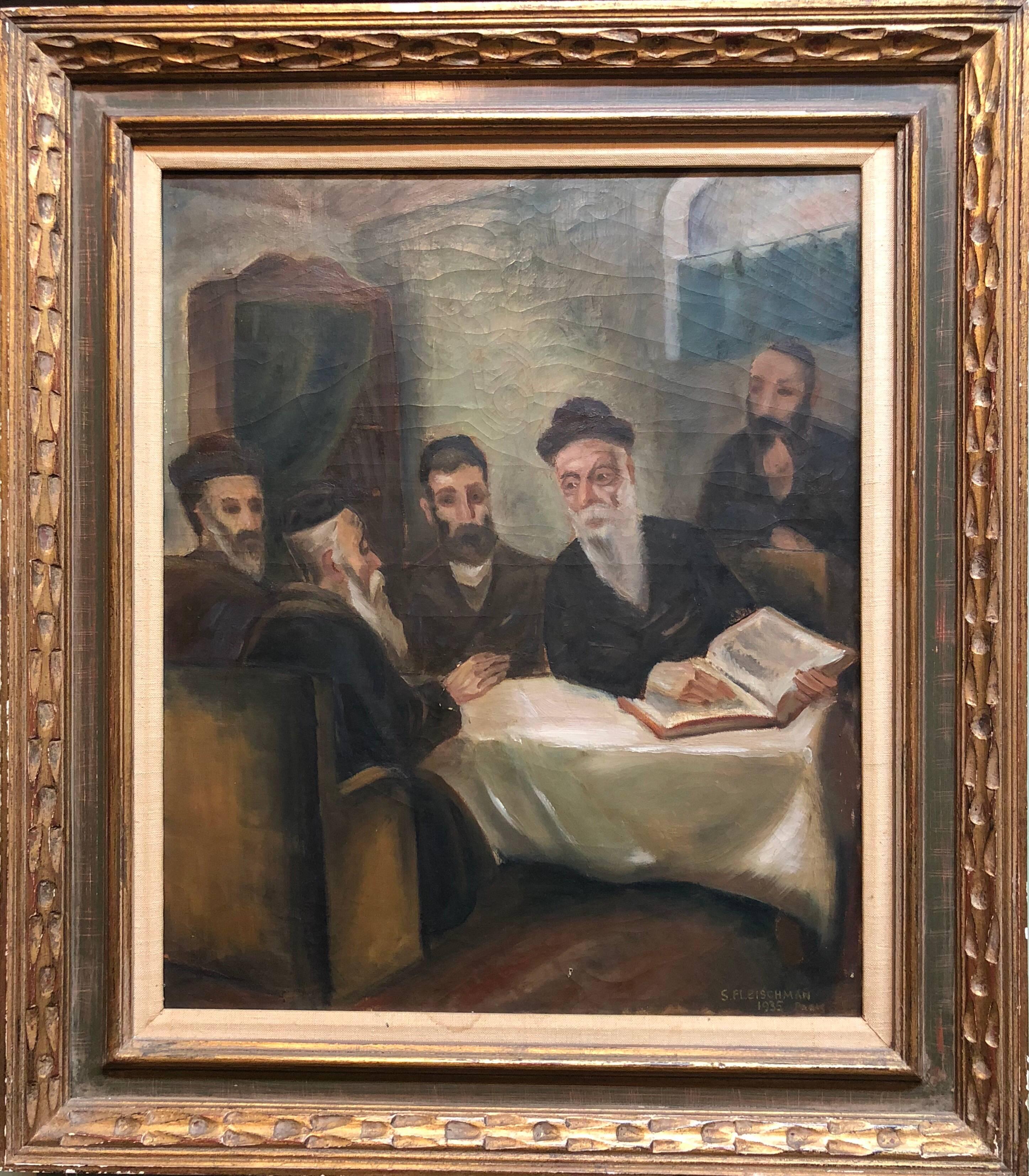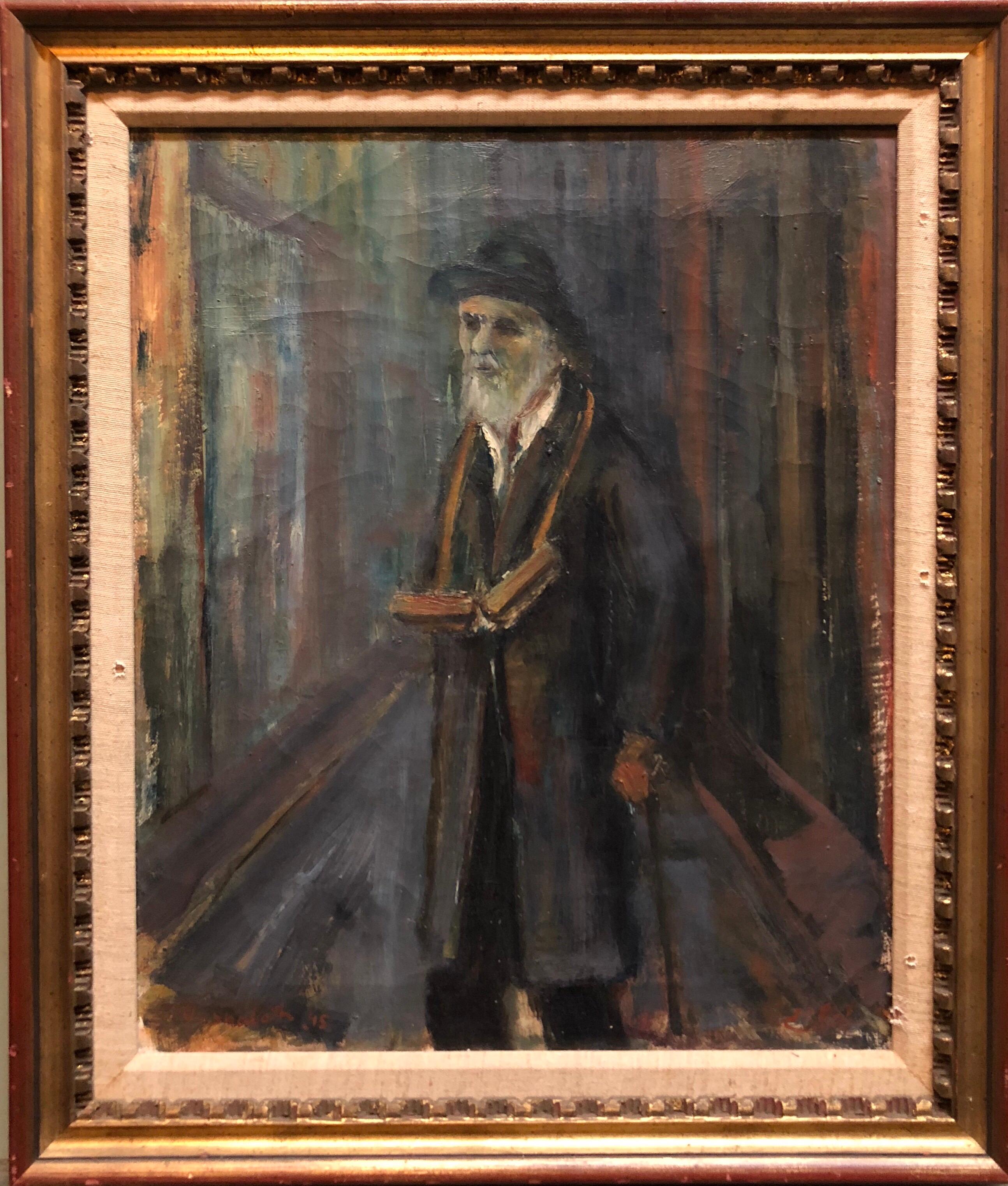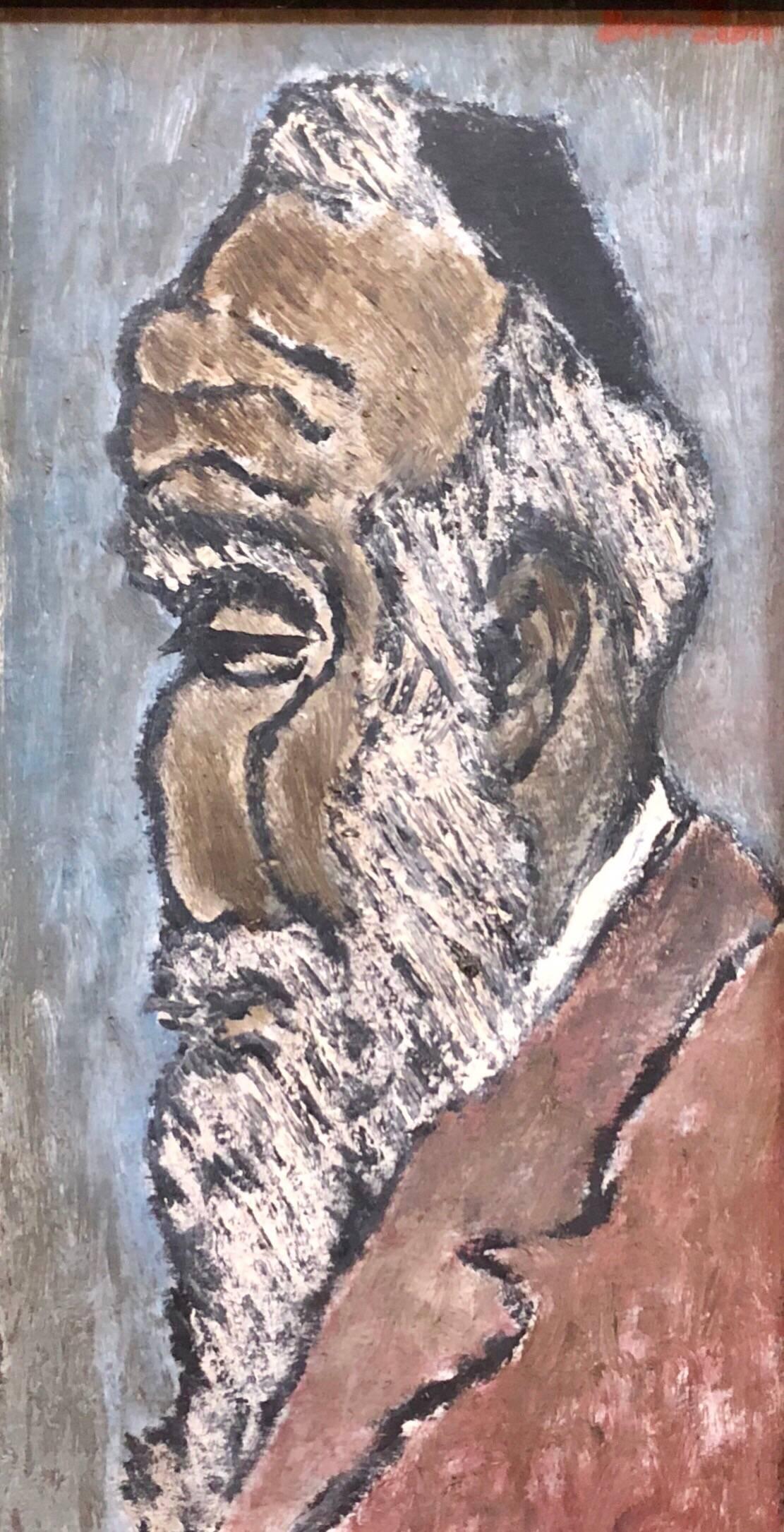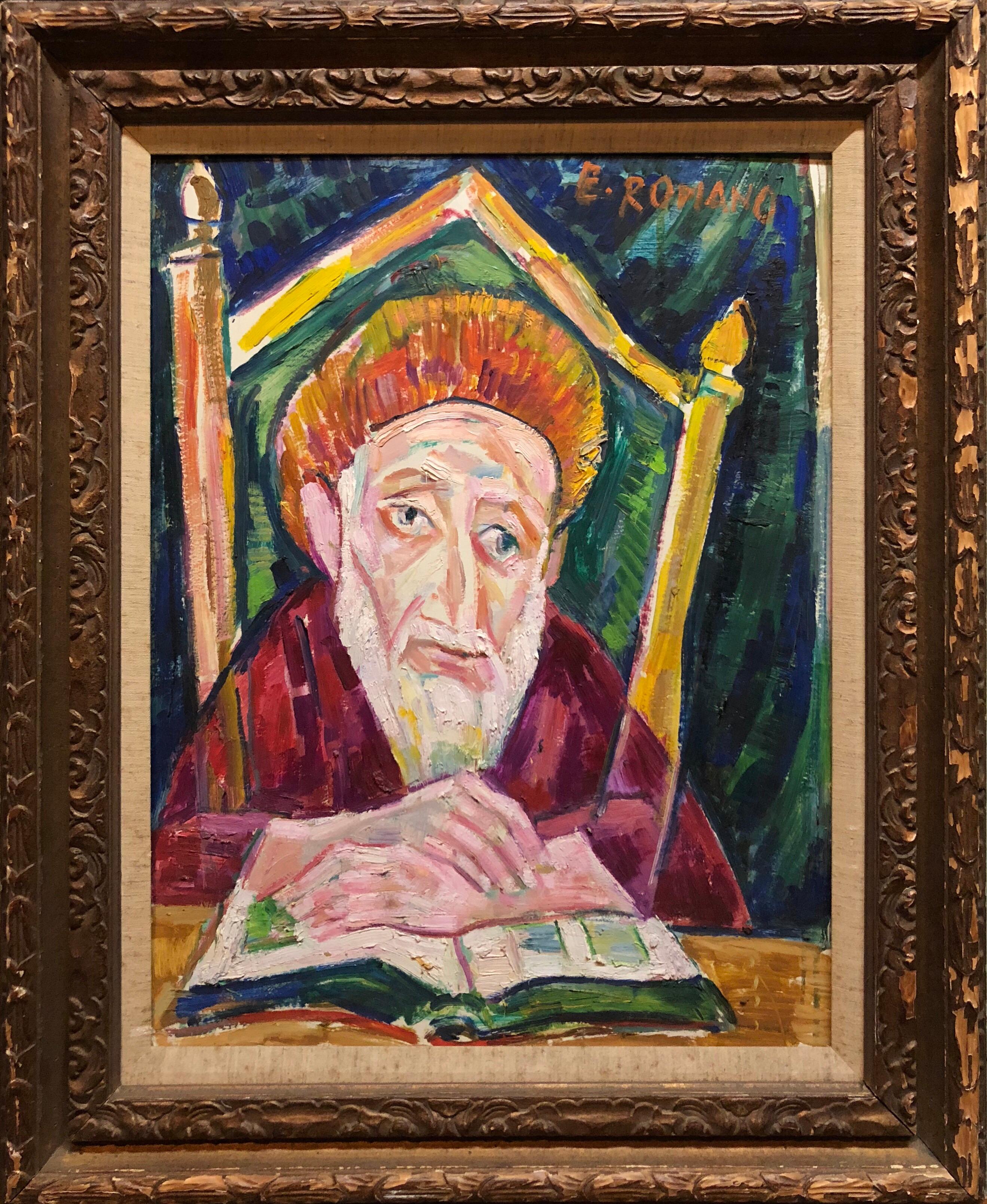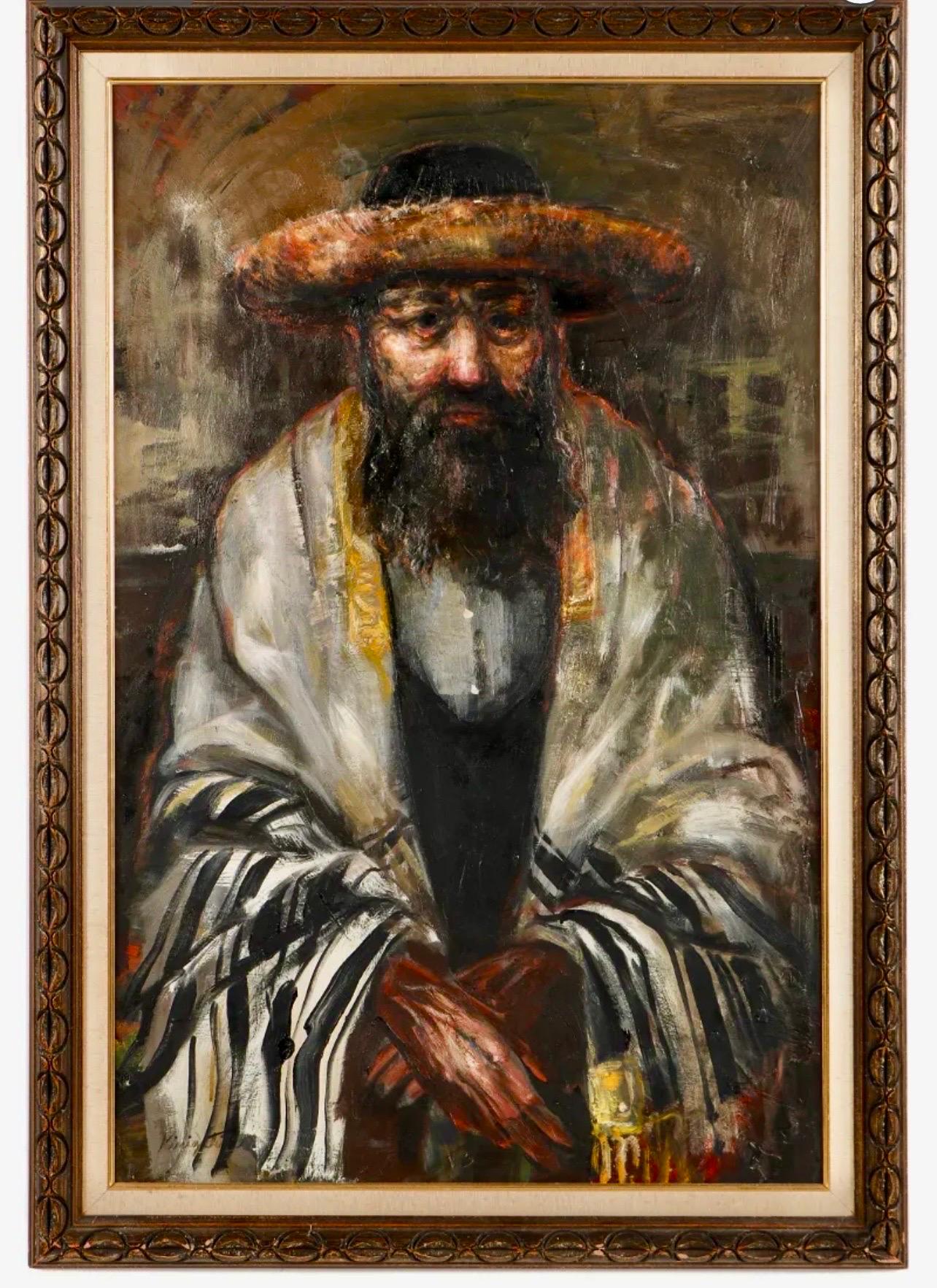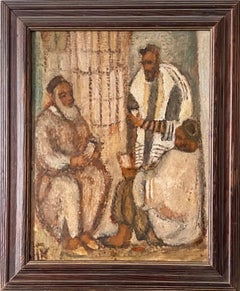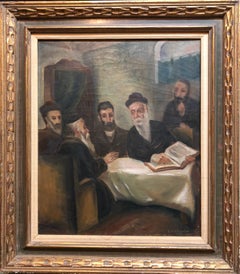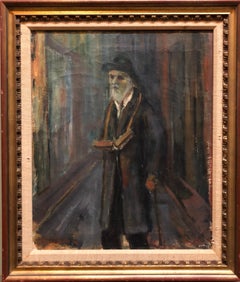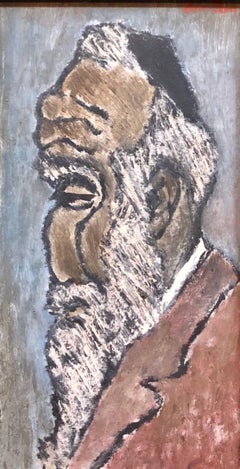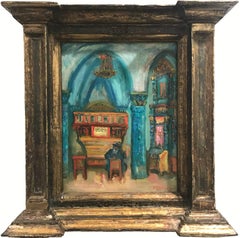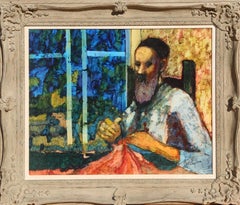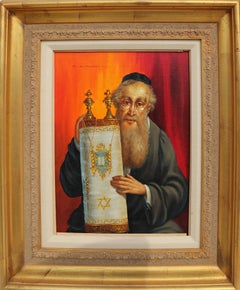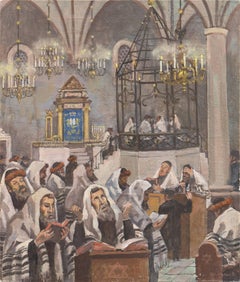Items Similar to Modernist Rabbi Oil Painting Judaica Jewish Synagogue Scene Paris. Lichtenstein.
Want more images or videos?
Request additional images or videos from the seller
1 of 9
Isaac Lichtenstein 1Modernist Rabbi Oil Painting Judaica Jewish Synagogue Scene Paris. Lichtenstein.c.1920's-1930's
c.1920's-1930's
$2,500
£1,908.40
€2,193.83
CA$3,517.95
A$3,912.10
CHF 2,054.72
MX$47,829.38
NOK 25,603.80
SEK 24,137.46
DKK 16,373.09
About the Item
Framed 26 x 13 image 20 x 6.5 inches.
YITSKHOK LIKHTENSHTEYN (ISAAC LICHTENSTEIN) (1888-1981) (Icchok, Izrael) was born in Lodz, Poland. Initially he was studying at Yehuda Pen school in Witebsk. In the same school where young Marc Chagall started to paint his shtetl Jews, Jewish neighbourhoods and personages. As many young Jewish children who decided painting to be their passion Isaac moved to Paris where he was one of the co-founders of Machmadim - a group of Jewish artists (mostly émigré from Eastern Europe) who dedicated their art to traditional Jewish themes. Later Isaac Lichtenstein studied with Boris Schatz and painted at Bezalel, Jerusalem. Until age seven he was raised in Warsaw; later, when his father received a position with Poznański, he lived with his parents in Lodz. There he studied in a state public school. He demonstrated talent for painting while still quite young, and in 1906 he began to attend the Cracow art academy, before going on to study painting in Rome, Florence, and Munich. In 1908 he entered the Bezalel Art School in Jerusalem. In 1910 he returned to Cracow, lived for a short time in Munich, 1911 in Paris, 1912-1913 again in the land of Israel, and in 1914 he returned to Paris, that very year setting off for the United States. He lived in New York during WWI, where he became part of Jewish literary and artistic circles, and contributed as a graphic artist to a variety of Jewish publications, among them: M. Basin’s Antologye (Anthology), the collection Velt ayn, velt oys (World in, world out), and designed frontispieces, little vignettes, and letters for Yiddish-language books. In 1916 he also began to write and published articles on the plastic arts in: Tsukunft (Future) in New York; the collection Shriften (Writings), vol. 6; Onheyb (Beginning), edited by Z. Vaynper; Morgn-zhurnal (Morning journal); Der amerikaner (The American); Forverts (Forward); and Di tsayt (The times). He did journalistic work also for M. F. Seidman’s correspondence bureau in New York. In 1918 he departed with the Jewish Legion for Israel. In 1920 he came to London, was demobilized there, and was a contributor to the journal Renesans (Renaissance), edited by Leo Kenig, and to the daily newspaper Di tsayt, edited by Morris Meyer. In 1924 he returned to Poland, exhibited his drawings in Warsaw, Lodz, Vilna, and other cities, gave speeches on art (general and Jewish), and published work in: Haynt (Today), Moment (Moment), Folkstsaytung (People’s newspaper), and Literarishe bleter (Literary leaves)—in Warsaw; Unzer lebn (Our life) in Grodno; Voliner lebn (Volhynia life); Nayer folksblat (New people’s newspaper) in Lodz; and elsewhere. He also published impressions from his travels and memoirs of the Jewish Legion in Haynt. He was part of the loose association of émigré artists known collectively as the École de Paris, the majority (among them Marc Chagall, Isaac Dobrinksy, Henri Epstein, Kikoïne, Isaac Lichtenstein, Jacques Lipchitz and Chaim Soutine) living and working together in the collection of studios known as La Ruche (‘the Beehive’) near the old Vaugirard slaughterhouses of Montparnasse. In 1927 he founded with the Parisian publisher Triangle a series entitled “Yidn-kinstler, monografyes” (Jewish artists, monographs), for which he wrote: Mark Shagal (Marc Chagall) (1927), 16 pp.; and Shmuel Hershenberg (Samuel Hirszenberg) (1928), 19 pp. Both of these monographs were translated into English and published in B’nai B’rith Magazine. In 1938 he commenced a world exhibition in New York and there he remained. In 1941 he revived in New York the art publisher Maḥmadim (founded in Paris in 1912), and it published: his art portfolio Yerushalayim (Jerusalem), 10 plates; Yankev Glatshteyn’s Yosl loksh fun khelem (Yosl Noodle from Chełm), with music by Henekh Kon and illustrations by Likhtenshetyn (1944); Geto-motivn (Ghetto motifs) by the artist Avrom Volkovitsh, with an appreciation of the artist by Likhtenshteyn (1946); the album, Kedoshim, lider far farpaynikte (Martyrs, songs for those who suffered), with Likhtenstein’s drawings and music by Henekh Kon (1947). He served as director of the art center of the World Jewish Culture Congress in New York. He arranged exhibitions of Jewish and Israeli artists, ran series of art-evenings in the auditorium of the Jewish Museum, designed covers for Yiddish books, and contributed work to: Tsukunft (Future), Idisher kemfer (Jewish fighter), Legyonern-zhurnal (Legionnaire’s journal), Unzer tsayt (Our time), the anthology Vitebsk amol (Vitebsk in the past), and Almanakh yidish (Yiddish almanac), among other publications. In 1960 he made a long trip to Europe and the state of Israel. He was last living in New York.
After WW2 he moved to New York and dedicated his life to painting and publishing illustrated Jewish books. He also helped many young Jewish artists to emerge on scene. Not many of Isaac Lichtenstein's paintings survived Holocaust and wars. But there are some held at the Ben Uri collection in London. He was included in an important exhibition there along with Abraham Mintchine, Elie Nadelman, Frank Auerbach, Issachar ber Ryback, Jankel Adler and Sonia Delaunay.
- Creator:
- Creation Year:c.1920's-1930's
- Dimensions:Height: 26 in (66.04 cm)Width: 13 in (33.02 cm)
- Medium:
- Movement & Style:
- Period:
- Condition:Good. minor wear to frame commensurate with age.
- Gallery Location:Surfside, FL
- Reference Number:1stDibs: LU38215942452
About the Seller
4.9
Platinum Seller
Premium sellers with a 4.7+ rating and 24-hour response times
Established in 1995
1stDibs seller since 2014
1,800 sales on 1stDibs
Typical response time: <1 hour
- ShippingRetrieving quote...Shipping from: Surfside, FL
- Return Policy
Authenticity Guarantee
In the unlikely event there’s an issue with an item’s authenticity, contact us within 1 year for a full refund. DetailsMoney-Back Guarantee
If your item is not as described, is damaged in transit, or does not arrive, contact us within 7 days for a full refund. Details24-Hour Cancellation
You have a 24-hour grace period in which to reconsider your purchase, with no questions asked.Vetted Professional Sellers
Our world-class sellers must adhere to strict standards for service and quality, maintaining the integrity of our listings.Price-Match Guarantee
If you find that a seller listed the same item for a lower price elsewhere, we’ll match it.Trusted Global Delivery
Our best-in-class carrier network provides specialized shipping options worldwide, including custom delivery.More From This Seller
View AllSynagogue Interior Jerusalem Modernist Israeli Judaica Oil Painting Rabbi Prayer
By Arieh Allweil
Located in Surfside, FL
ARIEH ALLWEIL (ARIE ALWEIL) 1901-1967
Galicia 1901-1967 Safed, Israel (Ukrainian/Polish/Israeli)
Arieh Allweil, born 1901, Galicia. Immigrated to Palestine in 1920. Studies: 1921-25...
Category
20th Century Modern Figurative Paintings
Materials
Canvas, Oil, Board
Rare French, Paris 1935 Judaica Oil Painting Rabbis Studying S. Fleischman
Located in Surfside, FL
Rare Judaica Art. Jewish genre scene. In the tradition of Moritz Oppenheim, Isidor Kauffman and Maurycy Gottlieb and later of Tully Filmus, Zalman Kleinman and Itshak Holtz the artist captures this Jewish scene with a particular sensitivity. Part of the Ecole De Paris The term "School of Paris" was used in 1925 by André Warnod (fr) to refer to the many foreign-born artists who had migrated to Paris.
School of Paris artists were progressively marginalized. Beginning in 1935 art publications no longer wrote about Marc Chagall, just magazines for Jewish audiences, and by June 1940 when the Vichy government took power, School of Paris artists could no longer exhibit in Paris at all.
The artists working in Paris between World War I and World War II experimented with various styles including Cubism, Orphism, Surrealism and Dada. Foreign and French artists working in Paris included Jean Arp, Joan Miró, Constantin Brâncuși, Raoul Dufy, Tsuguharu Foujita, artists from Belarus like Michel Kikoine, Pinchus Kremegne, and Jacques Lipchitz, the Polish artist Marek Szwarc and others such as Russian-born prince Alexis Arapoff. A significant subset, the Jewish artists, came to be known as the Jewish School of Paris or the School of Montparnasse. The "core members were almost all Jews, and the resentment expressed toward them by French critics in the 1930s was unquestionably fueled by anti-Semitism." One account points to the 1924 Salon des Indépendants, which decided to separate the works of French-born artists from those by immigrants; in response critic Roger Allard (fr) referred to them as the School of Paris. Jewish members of the group included Emmanuel Mané-Katz, Chaim Soutine, Adolphe Féder, Chagall, Moïse Kisling, Maxa Nordau...
Category
Mid-20th Century Post-Impressionist Figurative Paintings
Materials
Oil, Board
Judaica Oil Painting 1945 Palestine Old Jewish Man Polish Israeli Artist
By Ozer Shabat
Located in Surfside, FL
Ozer Shabat 1978-1901
Ozer Shabbat was an Israeli painter, a resident of Haifa. Belonged to the Palestine Expressionist group of the late 1920s and early 1930s.
Shabbat was born in Wolbrom, Poland. At the end of the First World War he went to Holland for agricultural training in the framework of the HeChalutz movement, prior to his immigration to Palestine. In 1920 he immigrated to Eretz Israel and joined the Hulda group. Later he joined the Merhavia group and there he began painting. Because of his desire to study drawing, he left the group and moved to Jerusalem. In 1921, he wrote articles in the newspaper "HaSadeh" on the subject of agriculture and Dutch cheese.
Ozer Shabath won the first prize in a competition for the design of the Dutch Consulate's Garden in Jerusalem, enabling him to travel to Paris in 1923 to study painting. Until 1925 he studied painting at the Grande Chaumiere Academy in Paris. This year he returned to Eretz Israel and settled in Haifa, where he lived until his death.
In 1928 he participated for the first time in an exhibition of Eretz Israel artists at the Tower of David. Since then he has participated in all the general exhibitions of Israeli artists. In 1934, together with painters Menachem Shemi, Avraham Mohar, Zvi Meirovitch and others, he founded the Haifa Artists' Group. In 1935-36 he toured Europe and visited Italy, France and England. During his visit, he maintained contacts with artists from the Jewish school of Paris.
He has exhibited in several solo exhibitions, represented Israel in exhibitions in Europe and participated in international exhibitions in New York, Johannesburg and Zurich. In 1958 he represented Israel in the Venice Biennale. In 1960, Shabat, together with Elchanan Halpern he represented the Israeli Painters Association at the International Congress of Plastic Arts held in Vienna, Austria . In the 40s and 50s he focused on landscape pictures. However, despite the focus on the Israeli landscape, the approach is universal in the framework of the post-Impressionist painting school. In the 1960s, his approach changed and he turned more to abstraction. The abstract direction gradually evolved. The point of departure of the abstract approach is the architectural landscape, but this view loses its real character and becomes only imaginary: the buildings lose their real character and turn into exclusive geometric areas that are usually set against a dark background. Over time, architecture captured the lion's share of his paintings. Cities like Safed, Jaffa and Jerusalem are the subject of many pictures.
He taught painting and art at the schools of the kibbutzim in Ramat Yochanan and Kfar Yehoshua, in high schools in Haifa and in the IDF and Gordon seminars.
His paintings were purchased and are in the permanent collection of the Bezalel National Museum (now the Israel Museum), Haifa Museum of Art, Haifa Maritime Museum, Acre Municipal Museum.
Select Solo exhibitions
1936 - Nadler Gallery, Haifa.
1943 - The Tel Aviv Museum of Art.
1952 - Artists House, Haifa.
1953 - Bezalel House, Jerusalem.
1955 - Gallery in Geneva, Switzerland.
1955 - The Writers' Club, Haifa.
1959 - Artists House, Haifa.
1960 - Museum of Modern Art, Haifa.
1962 - Museum of Modern Art, Haifa.
1963 - Gallery 220, Tel Aviv.
1968 - The Municipal Museum of Beit Emanuel, Ramat Gan.
1979 - Memorial exhibition marking the first anniversary...
Category
1940s Post-Impressionist Figurative Paintings
Materials
Canvas, Oil
Modernist Judaica Oil Painting "Old Jew" Jewish Rabbi at Prayer
By Ben-Zion Weinman
Located in Surfside, FL
An oil on board Judaic painting by modern artist Ben-Zion Weinman. It depicts a portrait in profile of an old Jew. The work is signed "Ben-Zion".
Born in 1897, Ben-Zion Weinman celebrated his European Jewish heritage in his visual works as a sculptor, painter, and printmaker. Influenced by Spinoza, Knut Hamsun, and Wladyslaw Reymont, as well as Hebrew literature, Ben-Zion wrote poetry and essays that, like his visual work, attempt to reveal the deep “connection between man and the divine, and between man and earth.”
An emigrant from the Ukraine, he came to the US in 1920. He wrote fairy tales and poems in Hebrew under the name Benzion Weinman, but when he began painting he dropped his last name and hyphenated his first, saying an artist needed only one name.
Ben-Zion was a founding member of “The Ten: An Independent Group” The Ten” a 1930’s avant...
Category
1940s American Modern Figurative Paintings
Materials
Oil, Board
Modernist Oil Painting 1940s, Judaica Hasidic Rabbi in Jerusalem
By Emanuel Glicenstein Romano
Located in Surfside, FL
Genre: Portrait
Subject: Landscape
Medium: Oil
Surface: Board
Country: United States
EMANUEL ROMANO
Rome, Italy, b. 1897, d. 1984
Emanuel Glicenstein Romano was born in Rome, September 23, 1897.
His father Henryk Glicenstein was a sculptor and was living in Rome with his wife Helena (born Hirszenberg) when Emanuel was born. His father obtained Italian citizenship and adopted the name Enrico. Emanuel was brought up in Italy, Switzerland, Germany, England and Poland.
In 1926 Emanuel and his father sailed for New York. They briefly visited Chicago. Romano's sister, Beatrice, and mother only joined them in New York years later.
Romano changed his name on his arrival to America and some have erroneously speculated that this was to avoid antisemitic discrimination. In truth, as the son of a highly-regarded artist, Romano changed his name to ensure that any success or recognition he would later attain, would be the result of nothing other than his own merit as an artist, and not on account of his father's fame.
In 1936 Romano was worked for the Federal Art Project creating murals. During and immediately after World War II, Romano created a series of allegorical works depicting graphic holocaust images that were held closely by the family until after his passing. One of these works is now on permanent display in the Florida Holocaust Museum in St. Petersburg Florida.
Emanuel's father died in 1942 in a car accident before they could realize their shared dream of visiting Israel.
In 1944 Romano, having completed his degree at the Pennsylvania Academy of Fine Arts and the Art Institute of Chicago, began teaching at the City College of New York.
Romano moved to Safed, Israel in 1953 and established an art museum in his father's memory, the Glicentein Museum.
COLLECTIONS
Indianapolis Museum of Art
Metropolitan Museum of Art
Boston Fine Arts Museum
Fogg Museum
Musée Nacional de France
Recently his work has been added to the Florida Holocaust Museum collection. His notable works include his holocaust themed allegorical paintings as well as portraits of Marianne Moore, his father and William Carlos Williams...
Category
1970s American Modern Figurative Paintings
Materials
Oil, Board
Large Judaica Oil Painting Rabbi Rediscovered NY Artist Simchat Torah
By Jonah Kinigstein
Located in Surfside, FL
"Simchat Torah" by Jonah Kinigstein
Large Oil on Board Painting of Rabbi
Frame: 46 X 32
Image: 39 X 25.5
Jonah Kinigstein (b. 1923) is an American Postwar & Contemporary painter. H...
Category
20th Century Expressionist Portrait Paintings
Materials
Oil, Board
You May Also Like
"Synagogue Interior Scene with Figure" Post-Impressionist Oil Painting on Canvas
By Jacques Zucker
Located in New York, NY
An outstanding oil painting depicting a religious figure seated in a Synagogue with decorated columns and in between arches. The bright colors and quick brush strokes are what make t...
Category
20th Century Post-Impressionist Figurative Paintings
Materials
Canvas, Oil
Rabbi 3, 1970s Framed Modern Oil Painting by Donald Roy Purdy
By Donald Roy Purdy
Located in Long Island City, NY
Artist: Donald Roy Purdy, American (1924 - )
Title: Rabbi 3
Year: circa 1970
Medium: Oil on Masonite, signed l.r.
Size: 24 x 30 in. (60.96 x 76.2 cm)
Frame Size: 34 x 39 inches
Category
1970s Modern Figurative Paintings
Materials
Masonite, Oil
Rabbi and Torah, Oil Painting by Abraham Straski
By Abraham Straski
Located in Long Island City, NY
Artist: Abraham Straski, Polish (1903 - 1987)
Title: Rabbi and Torah
Year: circa 1957
Medium: Oil on Canvas, signed l.r.
Image Size: 16 x 12 inches
Frame Size: 26 x 20 inches
Category
1950s Post-War Portrait Paintings
Materials
Canvas, Oil
'Interior of Synagogue with Rabbi', Polish Orthodox Judaica, Israel, Pentateuch
By Mieczyslaw Watorski
Located in Santa Cruz, CA
Signed lower right, 'M. Watorski' for Mieczyslaw Watorski (Polish, 1903 - 1979) and painted circa 1950.
This Polish history and landscape painter is particularly revered for his doc...
Category
1940s Interior Paintings
Materials
Canvas, Oil
Rabbi, 1970s Oil Painting by Donald Roy Purdy
By Donald Roy Purdy
Located in Long Island City, NY
Artist: Donald Roy Purdy, American (1924 - )
Title: Rabbi with Torah
Year: circa 1970
Medium: Oil on Masonite, signed l.r.
Size: 30 x 22.5 in. (76.2 x 57.15 cm)
Frame Size: 38 x 31 i...
Category
1970s Modern Figurative Paintings
Materials
Masonite, Oil
Rabbi with Torah, 1970s Oil Painting by Donald Roy Purdy
By Donald Roy Purdy
Located in Long Island City, NY
Artist: Donald Roy Purdy, American (1924 - )
Title: Rabbi with Torah
Year: circa 1970
Medium: Oil on Masonite, signed l.r.
Size: 36 x 24 in. (91.44 x 60.96 cm)
Frame Size: 45 x 31 in...
Category
1970s Modern Figurative Paintings
Materials
Masonite, Oil
More Ways To Browse
C M Young
Antique Journal
Jewish Antique
London 1920s Painting
Jew Painting
English Renaissance Painting
Jewish Plates
Antique Jewish Art
Lichtenstein Studio
1930s Magazine Illustration
Ben Long
Synagogue Painting
Jewish Rabbi Painting
Rabbi Studying
Magazine Covers 1930s
Antique Judaica
1911 Antiques
Jewish Synagogue
